-
 Bitcoin
Bitcoin $83,458.2141
-2.67% -
 Ethereum
Ethereum $1,573.6456
-4.30% -
 Tether USDt
Tether USDt $0.9999
0.01% -
 XRP
XRP $2.0723
-3.70% -
 BNB
BNB $581.4005
-1.36% -
 Solana
Solana $125.3253
-5.03% -
 USDC
USDC $0.9999
0.01% -
 TRON
TRON $0.2521
-0.43% -
 Dogecoin
Dogecoin $0.1540
-4.20% -
 Cardano
Cardano $0.6060
-5.85% -
 UNUS SED LEO
UNUS SED LEO $9.3707
-0.67% -
 Chainlink
Chainlink $12.2460
-4.06% -
 Avalanche
Avalanche $18.8097
-5.97% -
 Stellar
Stellar $0.2350
-2.48% -
 Toncoin
Toncoin $2.8686
-1.83% -
 Shiba Inu
Shiba Inu $0.0...01164
-2.94% -
 Sui
Sui $2.0816
-5.70% -
 Hedera
Hedera $0.1573
-6.20% -
 Bitcoin Cash
Bitcoin Cash $320.5595
-3.74% -
 Litecoin
Litecoin $75.7877
-3.38% -
 Polkadot
Polkadot $3.5343
-4.17% -
 Dai
Dai $1.0000
0.02% -
 Bitget Token
Bitget Token $4.2107
-2.77% -
 Hyperliquid
Hyperliquid $14.8217
-8.30% -
 Ethena USDe
Ethena USDe $0.9991
0.01% -
 Pi
Pi $0.6083
-18.46% -
 Monero
Monero $218.6656
2.90% -
 Uniswap
Uniswap $5.1744
-4.43% -
 OKB
OKB $52.3741
0.05% -
 Pepe
Pepe $0.0...07062
-5.76%
What are Binance's coin listing standards?
Binance's rigorous coin listing process involves extensive security audits, team background checks, legal compliance reviews, community engagement analysis, and thorough evaluation of tokenomics and utility, taking months and offering no listing guarantee despite meeting all criteria.
Feb 28, 2025 at 05:30 am
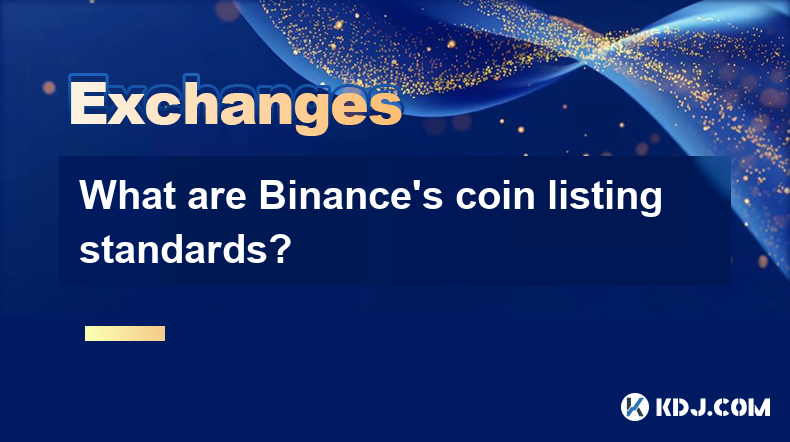
What are Binance's Coin Listing Standards? A Deep Dive into the Criteria for Token Inclusion on the World's Largest Exchange
Key Points:
- Binance's coin listing process is rigorous and multi-faceted, focusing on security, compliance, and project viability. It's not a simple application process but a thorough vetting procedure.
- The criteria encompass technical aspects of the blockchain, the project's team, legal compliance, community engagement, and market fundamentals. Each area undergoes intense scrutiny.
- Transparency is a key aspect, although Binance doesn't publicly disclose a comprehensive, numerical scoring system. The general criteria are outlined, allowing projects to understand the expectations.
- Meeting the standards doesn't guarantee listing; competition is fierce, and Binance prioritizes projects they believe offer the most value to their users.
- The listing process can be lengthy, often taking several months, as Binance conducts extensive due diligence.
- Security Audit and Technical Assessment:
Binance places paramount importance on the security of the projects it lists. This involves a meticulous technical assessment of the blockchain's architecture, smart contracts (if applicable), and overall security posture. This isn't a cursory review; Binance employs its internal security team and frequently outsources to reputable third-party auditing firms specializing in blockchain technology. These audits delve deep into the codebase, looking for vulnerabilities that could be exploited by hackers. They examine the consensus mechanism, checking for robustness and resilience against attacks like 51% attacks. The smart contract code undergoes rigorous testing to identify potential bugs, reentrancy vulnerabilities, and other exploits. The assessment also extends to the overall infrastructure supporting the blockchain, including node distribution, network performance, and the availability of tools for monitoring and maintenance. Furthermore, Binance investigates the team's security practices, assessing their response protocols in the event of a security breach and their commitment to addressing vulnerabilities promptly and transparently. A comprehensive security audit is not merely a box-ticking exercise; it’s a critical element in protecting the exchange's users and maintaining the integrity of the platform. The depth and breadth of this audit often involve multiple rounds of feedback and revisions, extending the overall listing timeline significantly. The goal isn't simply to identify vulnerabilities but to understand the project's commitment to long-term security and its ability to mitigate risks proactively. The outcome of this phase directly impacts the decision to proceed with the listing process. A failure to meet the stringent security standards would immediately disqualify a project.
- Team Assessment and Background Checks:
Binance conducts thorough background checks on the project's development team. This goes beyond simply reviewing resumes; it involves verifying identities, assessing experience, and investigating any potential red flags. The team's track record is scrutinized, evaluating past projects, successes, and failures. The exchange seeks evidence of technical expertise and experience in the blockchain space, paying close attention to the team's ability to deliver on their promises. The assessment includes analyzing the team's structure, looking for clear roles and responsibilities, and identifying key personnel with expertise in various areas such as development, marketing, and community management. Binance also considers the team's commitment to the project's long-term vision, evaluating their ability to adapt to changing market conditions and navigate challenges. Furthermore, the exchange investigates the team's reputation within the cryptocurrency community, looking for any evidence of past controversies or unethical behavior. This process often involves contacting references and conducting interviews to gather a holistic understanding of the team's capabilities and character. The goal is to ensure the project is led by a competent, trustworthy, and dedicated team capable of sustaining the project over the long term. A weak or untrustworthy team is a significant risk factor for Binance, and thorough due diligence is crucial in mitigating this risk. The process aims to identify potential conflicts of interest, fraudulent activities, or any behavior that might negatively impact the project's reputation or its users.
- Legal and Regulatory Compliance:
Binance operates in a highly regulated environment, and its coin listing standards reflect this. Projects must demonstrate compliance with relevant laws and regulations in jurisdictions where Binance operates. This involves a thorough review of the project's legal structure, ensuring it adheres to anti-money laundering (AML) and know-your-customer (KYC) regulations. The exchange investigates the project's tokenomics, ensuring they comply with securities laws and regulations. This includes a careful analysis of the token's utility, distribution, and governance model to determine whether it meets the criteria for being classified as a security. Failure to meet these regulatory standards could result in significant legal ramifications for Binance, and therefore, stringent compliance checks are a non-negotiable part of the listing process. The exchange works with legal experts to ensure all aspects of the project comply with the ever-evolving legal landscape of the cryptocurrency industry. This includes evaluating the project's whitepaper, token sale documents, and any other relevant legal documentation. The review also includes assessing the project's geographic reach and ensuring compliance with the specific regulations in the regions where it operates or intends to operate. The legal and regulatory compliance assessment is a critical step, and any concerns in this area could lead to the project being rejected outright.
- Community Engagement and Market Fundamentals:
Binance assesses the project's community engagement, examining the level of support and interest from users and investors. This involves analyzing social media activity, online forums, and other channels to gauge the community's sentiment towards the project. A strong, active, and engaged community is a positive indicator of the project's potential for long-term success. However, Binance also scrutinizes the community for any signs of manipulation or artificial inflation of interest. The exchange carefully evaluates the project's market fundamentals, including its tokenomics, market capitalization, trading volume, and overall market position. This analysis helps assess the project's potential for growth and sustainability. A thorough market analysis is crucial in determining whether the project offers value to Binance's users and whether it has the potential to become a successful and liquid asset on the exchange. The assessment also includes evaluating the project's competitive landscape, identifying its unique selling points, and assessing its potential for disruption within the cryptocurrency market. A strong market position and clear value proposition are key factors in Binance's decision-making process. Furthermore, Binance examines the project's overall development roadmap, looking for evidence of a clear plan for future growth and innovation.
- Tokenomics and Utility:
Binance scrutinizes the project's tokenomics, examining the token's supply, distribution, and utility. The exchange looks for clear and well-defined use cases for the token, ensuring it serves a genuine purpose within the project's ecosystem. The tokenomics model must be sustainable and avoid any features that could lead to price manipulation or unfair distribution. The distribution model is analyzed to identify any potential for concentration of power or unfair advantages to early investors. Binance carefully reviews the token's inflation rate and its potential impact on the long-term value of the token. A well-designed tokenomics model is crucial for the project's long-term viability and its ability to attract and retain users. The review also includes an assessment of the token's governance model, examining how decisions related to the project's development and future are made. Transparency and community involvement in governance are highly valued by Binance. The token's utility is critically examined to ensure it is not merely a speculative asset but serves a practical function within the project's ecosystem.
FAQs:
Q: How long does the Binance listing process take?
A: The process can take several months, sometimes even longer, depending on the complexity of the project and the thoroughness of the due diligence required. It's not a standardized timeline.
Q: Is there a fee to apply for a Binance listing?
A: Binance doesn't publicly disclose any listing fees. However, it’s generally understood that there aren’t direct fees, but the indirect costs associated with meeting the stringent requirements (security audits, legal counsel, etc.) can be substantial.
Q: What happens if my project doesn't meet all the listing standards?
A: Binance will provide feedback on areas needing improvement. Projects may be encouraged to address the shortcomings and reapply later. However, projects failing to meet fundamental criteria will be rejected.
Q: Does meeting all the standards guarantee a listing?
A: No, even if a project perfectly meets all the criteria, there's no guarantee of listing. Binance receives numerous applications, and selection is based on several factors, including market demand and the exchange's overall strategy.
Q: Where can I find the complete and detailed listing standards?
A: Binance doesn't publicly release a comprehensive, detailed checklist. The information provided above is based on publicly available information and general industry understanding. The exact specifics are likely confidential.
Q: Can I contact Binance directly to inquire about the status of my application?
A: Binance's communication channels for listing applications are usually limited, and direct contact is often not possible during the review process. They generally communicate updates as they deem necessary.
Q: What types of projects are typically listed on Binance?
A: Binance lists a wide range of projects, but generally prioritizes those with strong fundamentals, a robust community, clear utility, and a proven track record. They show preference for projects that they believe will provide value to their vast user base.
Disclaimer:info@kdj.com
The information provided is not trading advice. kdj.com does not assume any responsibility for any investments made based on the information provided in this article. Cryptocurrencies are highly volatile and it is highly recommended that you invest with caution after thorough research!
If you believe that the content used on this website infringes your copyright, please contact us immediately (info@kdj.com) and we will delete it promptly.
- Bitcoin (BTC) Dips Alongside Stock Futures as Nvidia Corp. NVDA Shares Tumble
- 2025-04-16 13:15:13
- Bitcoin (BTC) Faces a Critical Test as Global Markets Remain Volatile and Macroeconomic Tensions Escalate
- 2025-04-16 13:15:13
- Bitcoin (BTC) has been moving between $80,00 and $85,00 for the fourth day as the uncertain market for the U.S.-China trade dispute continues.
- 2025-04-16 13:10:12
- MicroStrategy (Formerly ) Doubles Down on BTC After a Performance in Q1 2025
- 2025-04-16 13:10:12
- Real-world asset-focused coin MANTRA OM/USD Topped The Cryptocurrency Gainers List On Tuesday
- 2025-04-16 13:05:13
- Semler Scientific Files to Issue $500M in Securities Following $30M DOJ Settlement
- 2025-04-16 13:05:13
Related knowledge

How do I contact customer service on Binance to resolve issues?
Mar 16,2025 at 04:30am
Key Points:Binance's customer service is primarily self-service, relying heavily on its help center and FAQs.Direct contact methods are limited, with email support being the most common route for non-urgent issues.Urgent issues may require using the in-app support system, though response times can vary.Understanding Binance's support structure and utili...
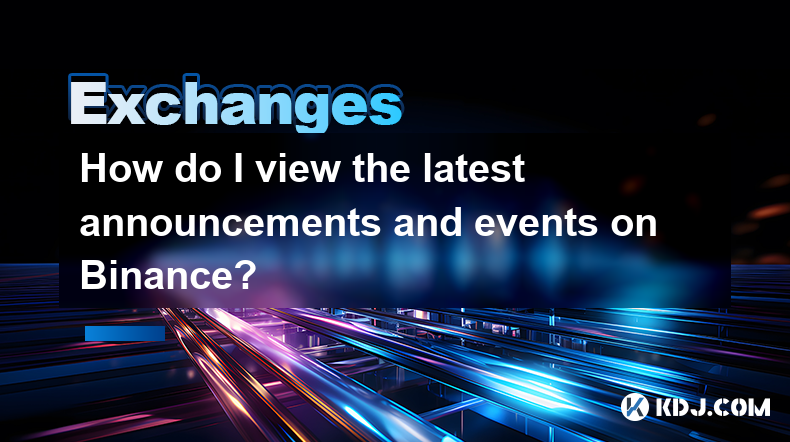
How do I view the latest announcements and events on Binance?
Mar 18,2025 at 10:18pm
Key Points:Binance utilizes multiple channels for disseminating announcements and events.The official Binance website is the primary source.Binance's social media platforms offer timely updates.Email subscriptions keep users informed about relevant announcements.Third-party aggregators can supplement official channels but require caution.How Do I View t...

How do I set up a subaccount on Binance?
Mar 14,2025 at 01:50pm
Key Points:Binance does not offer traditional "subaccounts" in the sense of separate accounts with independent logins under a master account.Instead, Binance offers features like user-defined labels for better portfolio management and API keys for automated trading. These provide functionality similar to subaccounts.Setting up these features involves na...
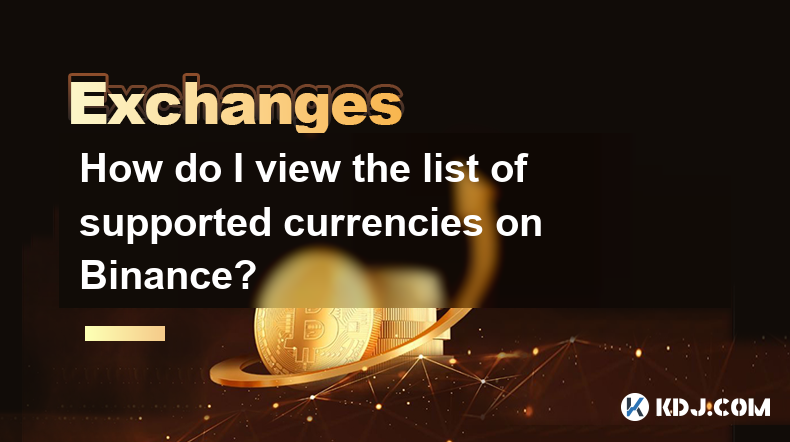
How do I view the list of supported currencies on Binance?
Mar 15,2025 at 05:35am
Key Points:Binance supports a vast and frequently updated list of cryptocurrencies. There's no single, static list.Finding supported currencies requires navigating Binance's website or app interfaces.Different sections of the exchange show different subsets of supported currencies (e.g., trading, staking, etc.).The availability of specific cryptocurrenc...
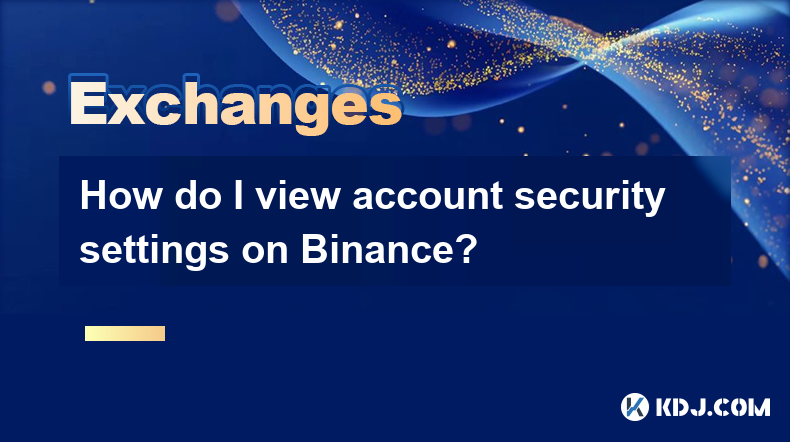
How do I view account security settings on Binance?
Mar 15,2025 at 08:40pm
Key Points:Binance's security settings are spread across multiple sections of your account. This article will guide you through each crucial area.Understanding and implementing these settings is paramount to protecting your cryptocurrency assets.We'll cover two-factor authentication (2FA), withdrawal whitelists, and other essential security features.Reg...
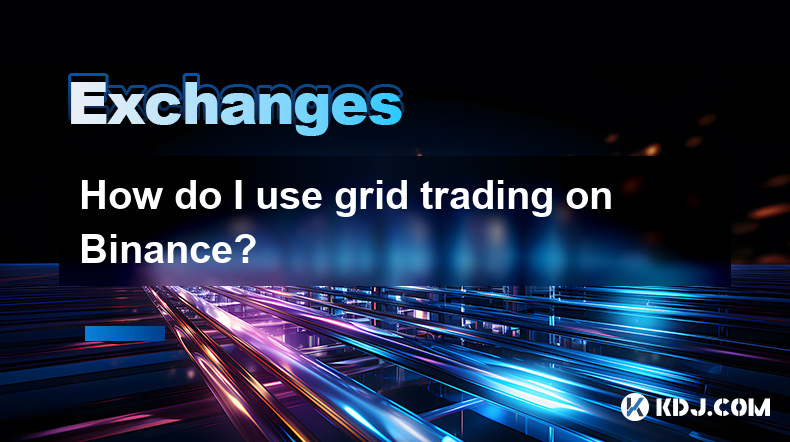
How do I use grid trading on Binance?
Mar 14,2025 at 04:25pm
Key Points:Grid trading on Binance involves automatically buying low and selling high within a defined price range.Binance offers a built-in grid trading bot, simplifying the process.Setting up a grid bot requires defining parameters like price range, grid quantity, and investment amount.Risk management is crucial, as losses are possible despite the aut...

How do I contact customer service on Binance to resolve issues?
Mar 16,2025 at 04:30am
Key Points:Binance's customer service is primarily self-service, relying heavily on its help center and FAQs.Direct contact methods are limited, with email support being the most common route for non-urgent issues.Urgent issues may require using the in-app support system, though response times can vary.Understanding Binance's support structure and utili...

How do I view the latest announcements and events on Binance?
Mar 18,2025 at 10:18pm
Key Points:Binance utilizes multiple channels for disseminating announcements and events.The official Binance website is the primary source.Binance's social media platforms offer timely updates.Email subscriptions keep users informed about relevant announcements.Third-party aggregators can supplement official channels but require caution.How Do I View t...

How do I set up a subaccount on Binance?
Mar 14,2025 at 01:50pm
Key Points:Binance does not offer traditional "subaccounts" in the sense of separate accounts with independent logins under a master account.Instead, Binance offers features like user-defined labels for better portfolio management and API keys for automated trading. These provide functionality similar to subaccounts.Setting up these features involves na...

How do I view the list of supported currencies on Binance?
Mar 15,2025 at 05:35am
Key Points:Binance supports a vast and frequently updated list of cryptocurrencies. There's no single, static list.Finding supported currencies requires navigating Binance's website or app interfaces.Different sections of the exchange show different subsets of supported currencies (e.g., trading, staking, etc.).The availability of specific cryptocurrenc...

How do I view account security settings on Binance?
Mar 15,2025 at 08:40pm
Key Points:Binance's security settings are spread across multiple sections of your account. This article will guide you through each crucial area.Understanding and implementing these settings is paramount to protecting your cryptocurrency assets.We'll cover two-factor authentication (2FA), withdrawal whitelists, and other essential security features.Reg...

How do I use grid trading on Binance?
Mar 14,2025 at 04:25pm
Key Points:Grid trading on Binance involves automatically buying low and selling high within a defined price range.Binance offers a built-in grid trading bot, simplifying the process.Setting up a grid bot requires defining parameters like price range, grid quantity, and investment amount.Risk management is crucial, as losses are possible despite the aut...
See all articles























































































